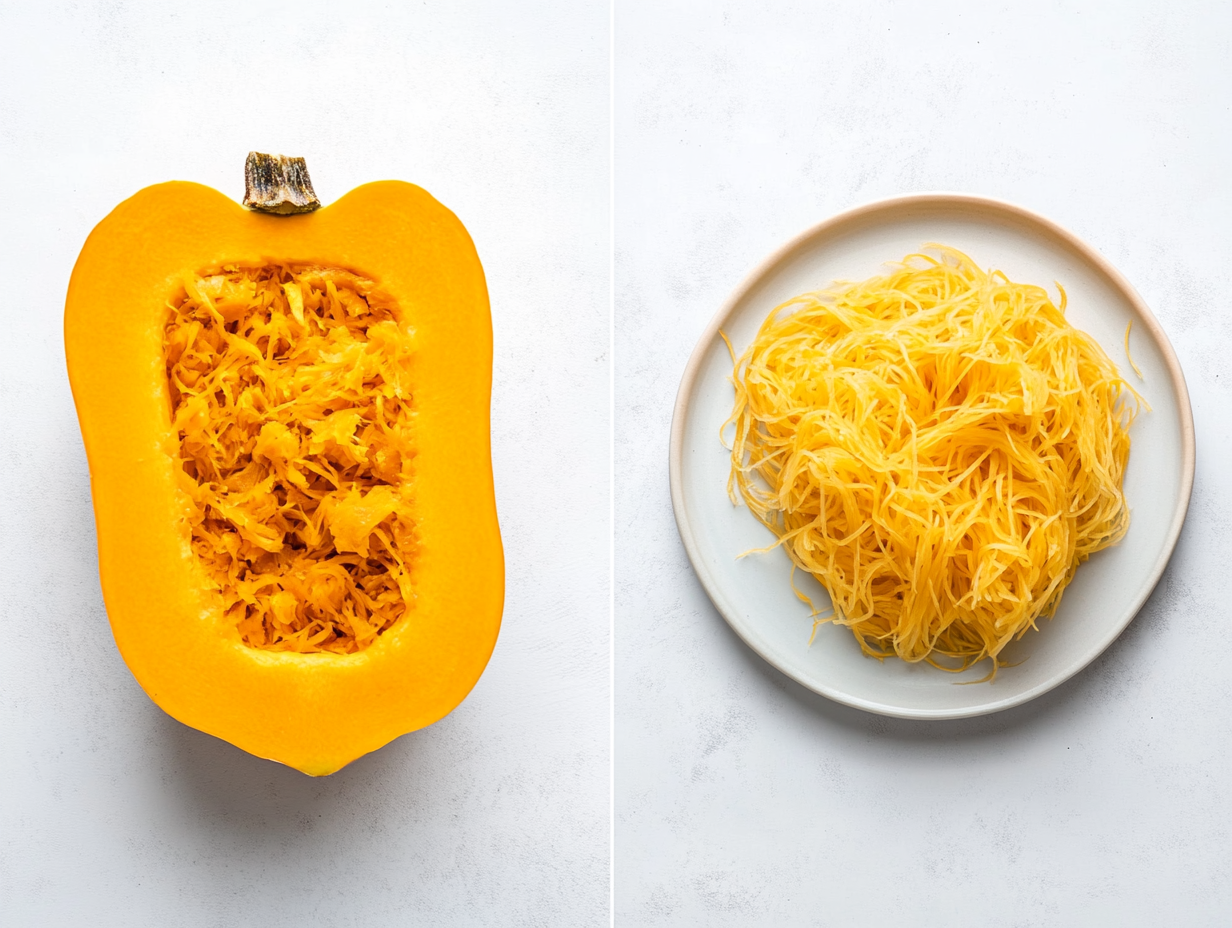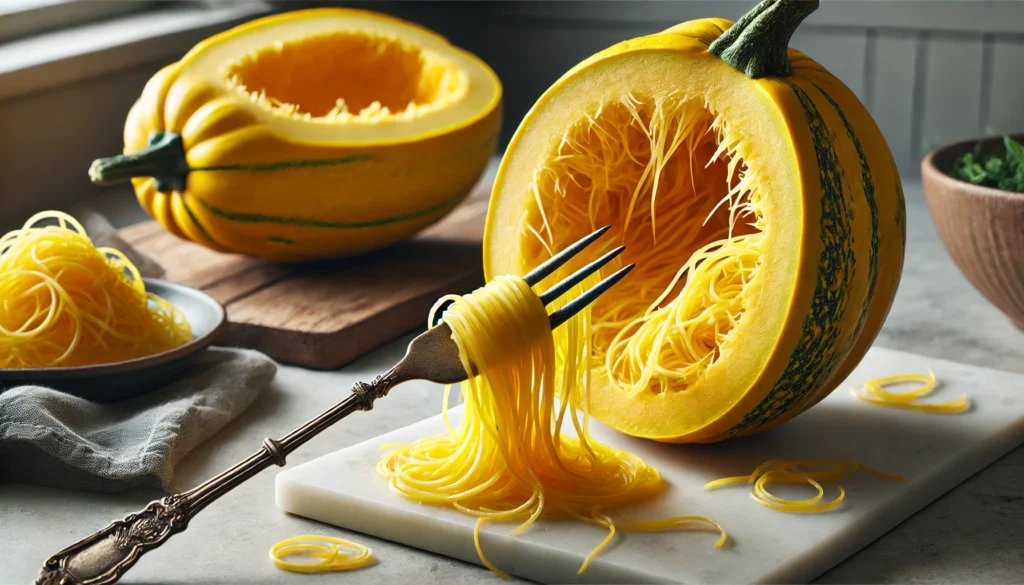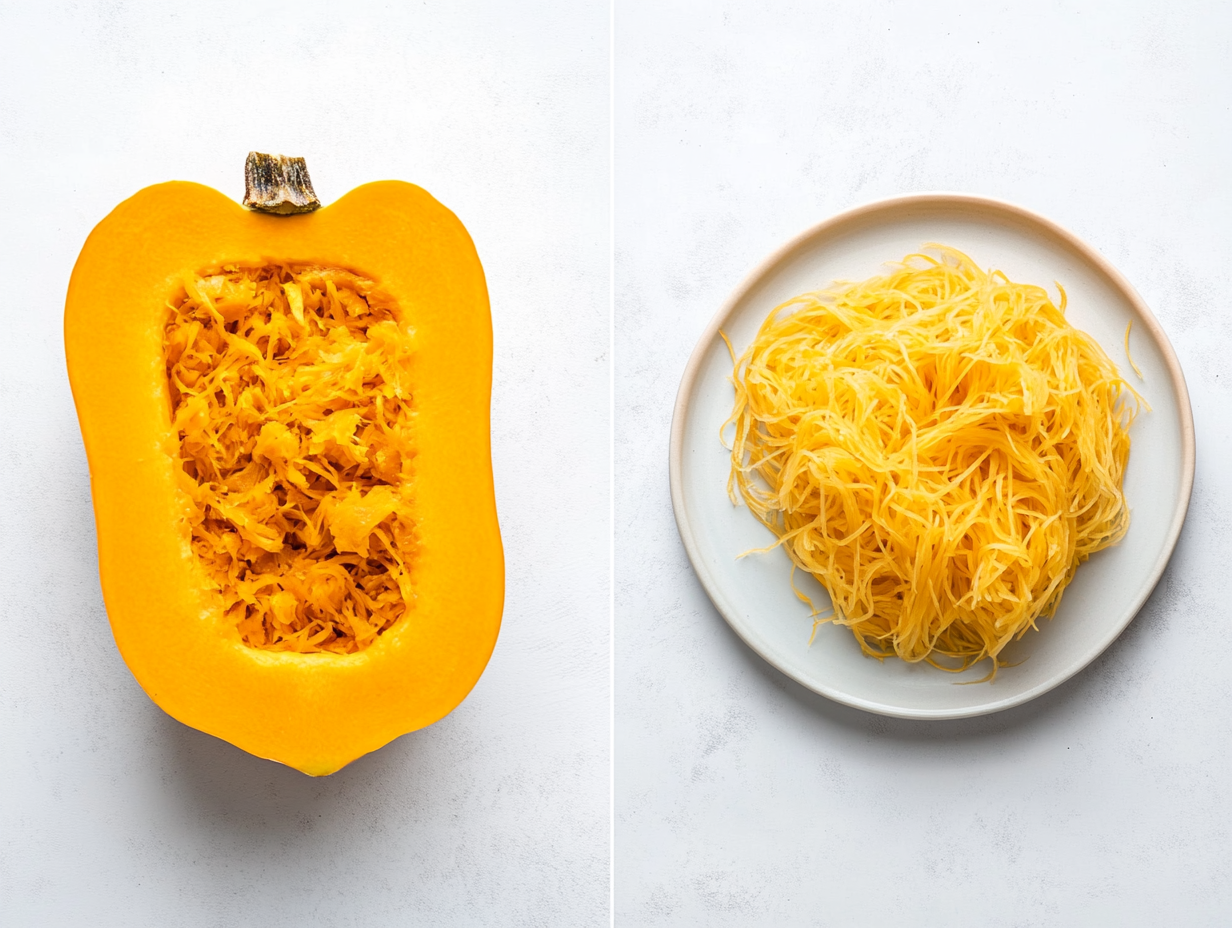Introduction

When it comes to winter squashes, confusion often arises between butternut squash and spaghetti squash. Though both belong to the same gourd family, their characteristics, textures, and culinary uses set them apart. This article delves into their distinctions and similarities, helping you make informed choices in your kitchen. By the end, you’ll understand how these squashes differ and when to use each, whether you’re cooking for health, flavor, or versatility.

Part 1: Understanding Winter Squashes
Overview of Winter Squash Varieties
Winter squashes are a diverse group of vegetables, harvested in the fall and known for their hard, protective rinds. These squashes are prized for their long shelf lives and nutrient-dense flesh, making them staples in many kitchens. Among the most popular varieties are butternut squash and spaghetti squash, each offering unique culinary possibilities.
These squashes vary widely in appearance, taste, and texture, which can lead to questions about their interchangeability in recipes. For example, butternut squash boasts a creamy texture and subtly sweet flavor, while spaghetti squash surprises with its stringy, pasta-like strands when cooked. Recognizing their differences is key to choosing the right squash for your culinary creations.
Importance of Differentiating Between Squash Types
Why does it matter to know the difference? Because using the wrong squash in a recipe can drastically alter its outcome. Imagine swapping creamy butternut squash in a soup for spaghetti squash—it wouldn’t quite work! Beyond recipes, understanding these squashes helps with grocery shopping, meal planning, and even exploring healthier substitutions.
Moreover, learning about their distinct traits enhances appreciation for how versatile winter squashes can be. Whether you’re roasting, mashing, or substituting squash for carbs, identifying the right type makes all the difference. With these basics in mind, let’s dive deeper into what sets butternut squash and spaghetti squash apart.
Part 2: Defining Butternut and Spaghetti Squash
What Is Butternut Squash?
Butternut squash is one of the most beloved winter squashes, known for its sweet, nutty flavor and versatility. This pale-orange gourd, with its smooth texture and bulbous shape, is a staple in kitchens worldwide. Its adaptability to various cooking methods makes it a favorite among chefs and home cooks alike.
Botanical Classification
Scientifically named Cucurbita moschata, butternut squash is a member of the Cucurbitaceae family, which also includes pumpkins, zucchinis, and cucumbers. Native to Central and South America, this squash thrives in warm climates and has been cultivated for centuries for its rich, starchy flesh.
Physical Characteristics
Butternut squash has a distinct shape, resembling a pear with a longer neck and a rounded base. Its skin is smooth and tan, while its flesh is a vibrant orange, indicating high beta-carotene content. Inside the base lies a small, hollow cavity filled with seeds, which can be roasted for an additional snack.
Common Culinary Uses
Known for its creamy consistency, butternut squash is frequently used in soups, purees, and roasted vegetable medleys. Its sweetness pairs well with savory spices like nutmeg, cumin, and sage, making it a versatile ingredient for both sweet and savory dishes. Additionally, butternut squash can be spiralized into noodles as a low-carb alternative to pasta.
What Is Spaghetti Squash?
Spaghetti squash is a unique winter squash celebrated for its ability to transform into stringy, spaghetti-like strands when cooked. This curious quality has made it a popular choice for those seeking healthier alternatives to traditional noodles.

Botanical Classification
Scientifically classified as Cucurbita pepo, spaghetti squash is also a member of the Cucurbitaceae family. While its origins trace back to North America, modern varieties have been cultivated worldwide. It’s typically grown as an annual crop in temperate climates.
Physical Characteristics
Spaghetti squash is oblong and cylindrical, with a hard rind that ranges in color from pale yellow to deep gold. Inside, the flesh is firm and pale, surrounded by a central cavity filled with seeds. When cooked, the flesh separates into strands that resemble spaghetti, lending this squash its name.
Common Culinary Uses
The primary appeal of spaghetti squash lies in its ability to mimic pasta. It’s often baked, roasted, or microwaved, then shredded into strands and topped with sauces like marinara, pesto, or Alfredo. Beyond pasta substitutes, spaghetti squash can be incorporated into casseroles, stir-fries, or enjoyed simply with a drizzle of olive oil and herbs.
Part 3: Comparing Butternut and Spaghetti Squash
Differences in Appearance
Shape and Size
One of the most noticeable differences between butternut squash and spaghetti squash is their shape. Butternut squash has a pear-like form, while spaghetti squash is more cylindrical and oblong. Butternut squash tends to be larger and heavier, making it more substantial for recipes requiring purees or cubes.
Skin Color and Texture
The skins of these squashes are another key identifier. Butternut squash has a smooth, tan skin that’s easy to peel, whereas spaghetti squash has a thicker, rougher rind, often with subtle ridges. These variations influence how the squash is prepared and cooked.
Flesh Color and Seed Cavity
Inside, butternut squash showcases a vibrant orange flesh, while spaghetti squash has pale yellow flesh. Additionally, butternut’s seed cavity is small and confined to the base, whereas spaghetti squash has a more elongated cavity running the length of the squash.
Differences in Texture and Flavor
Raw Texture and Taste
Raw butternut squash is dense, starchy, and slightly sweet, making it ideal for grating into salads or using in raw preparations. Spaghetti squash, on the other hand, is firmer and less sweet, with a mild, neutral flavor that isn’t as prominent in raw dishes.
Cooked Texture and Flavor Profiles
Once cooked, the differences become even more apparent. Butternut squash turns creamy and smooth, lending itself to soups, purees, and mashed dishes. Meanwhile, cooked spaghetti squash separates into strands that mimic pasta, offering a slightly crunchy, al dente texture. Its mild flavor absorbs the taste of sauces and seasonings, making it a chameleon in recipes.
Suitability for Various Dishes
Butternut squash is better suited for dishes requiring creaminess or sweetness, like pies, soups, and gratins. In contrast, spaghetti squash shines in recipes that highlight its noodle-like texture, such as pasta alternatives or stir-fry dishes.
Nutritional Comparison
Caloric Content
Both squashes are low in calories, making them ideal for weight-conscious diets. A one-cup serving of butternut squash contains approximately 82 calories, while the same amount of spaghetti squash contains just 42 calories.
Macronutrient Breakdown
Butternut squash is slightly higher in carbohydrates and sugars, providing a natural sweetness. Spaghetti squash, however, is lower in carbs, making it a go-to choice for keto or low-carb diets. Both are fat-free and provide a modest amount of protein.
Vitamins and Minerals
Butternut squash is rich in vitamins A and C, as well as potassium, magnesium, and manganese. Spaghetti squash offers similar nutrients but in slightly smaller amounts, emphasizing fiber content. Both contribute to a balanced, nutrient-dense diet.
Health Benefits and Considerations
Eating these squashes supports healthy digestion, boosts immunity, and promotes eye health due to their fiber and vitamin content. However, individuals managing blood sugar levels may prefer spaghetti squash due to its lower glycemic load.
Part 4: Culinary Applications
Cooking Methods for Butternut Squash
Roasting Techniques
Roasting is one of the most popular ways to prepare butternut squash, as it enhances its natural sweetness and creates a caramelized, slightly crispy exterior. To roast, peel the squash, remove the seeds, and cut it into cubes or slices. Toss the pieces with olive oil, salt, and spices such as cinnamon, paprika, or nutmeg, then bake at 400°F (200°C) for 25–30 minutes. Roasted butternut squash can be used as a side dish or added to grain bowls.
Soups and Purees
The smooth, creamy texture of butternut squash makes it ideal for soups and purees. After roasting or steaming, blend the flesh with vegetable broth, garlic, and a touch of cream for a velvety soup. Pureed butternut squash can also serve as a base for sauces or be mixed into mashed potatoes for a nutrient boost.
Incorporation into Salads and Stews
Butternut squash can elevate salads and stews by adding depth and sweetness. Roasted chunks pair beautifully with leafy greens, goat cheese, and walnuts for a hearty salad. In stews, its firmness holds up well when simmered, providing both flavor and texture to the dish.
Cooking Methods for Spaghetti Squash
Baking and Roasting
Preparing spaghetti squash often begins with baking or roasting, methods that bring out its mild, nutty flavor. Slice the squash lengthwise, scoop out the seeds, and brush the inside with olive oil. Place it cut-side down on a baking sheet and roast at 375°F (190°C) for 40–50 minutes. The result? Tender flesh that easily separates into strands.
Creating Spaghetti-Like Strands
Once roasted, use a fork to scrape the flesh, which naturally forms into spaghetti-like strands. This step is simple yet transformative, turning an ordinary vegetable into a versatile pasta alternative. The strands can be seasoned with herbs or topped with marinara for a wholesome dish.
Use as a Pasta Substitute
Spaghetti squash’s most famous use is as a pasta substitute. Its low-calorie and low-carb profile makes it a favorite among health-conscious eaters. Toss the strands with your favorite sauces, sautéed vegetables, or protein for a complete meal that’s lighter but still satisfying.
Recipe Ideas Highlighting Each Squash
Butternut Squash Recipes
- Classic Butternut Squash Soup: A comforting blend of roasted squash, cream, and warm spices.
- Maple-Roasted Butternut Squash: Perfect as a side dish or topping for salads.
- Butternut Squash Risotto: Creamy, luxurious, and packed with flavor.
Spaghetti Squash Recipes
- Spaghetti Squash Alfredo: A guilt-free twist on a creamy classic.
- Spaghetti Squash Stir-Fry: Tossed with soy sauce, garlic, and vegetables for an Asian-inspired meal.
- Mediterranean Spaghetti Squash: Loaded with olives, feta, and cherry tomatoes for a fresh and zesty dish.
Combining Both in a Single Dish
For a creative culinary adventure, try pairing the two squashes. For instance, layer roasted butternut squash slices with spaghetti squash strands in a lasagna-style casserole, adding ricotta and marinara for a delightful fusion dish.
Part 5: Selection and Storage
How to Select Quality Butternut and Spaghetti Squash
Indicators of Ripeness
When choosing butternut squash, look for a uniform tan color and a firm exterior. Spaghetti squash should have a bright yellow or golden hue with no green spots. Ripe squashes feel heavy for their size, indicating dense flesh.
Signs of Freshness
Fresh squash should be free from blemishes, soft spots, or cracks. The stem, if present, should be dry and firm. Avoid squashes with mold or discoloration, as these are signs of spoilage.
Avoiding Common Defects
Stay clear of squashes with deep cuts, bruises, or overly soft areas. These imperfections can reduce shelf life and indicate that the squash may be rotting inside. Always inspect the skin and gently press to ensure firmness.
Proper Storage Techniques
Short-Term Storage
For short-term storage, keep butternut squash and spaghetti squash in a cool, dark place, such as a pantry or cellar. They can last for several weeks under these conditions without refrigeration.
Long-Term Storage
If you need to store squashes for an extended period, consider curing them by letting them sit in a warm, dry area for about 10 days. This process hardens their skin and increases their shelf life to several months.
Preservation Methods
For maximum longevity, you can freeze cooked squash. Cube or puree butternut squash before freezing, while spaghetti squash strands can be stored in airtight containers. These methods ensure you always have a convenient option on hand for recipes.
Part 6: Frequently Asked Questions (FAQs)
FAQs About Butternut and Spaghetti Squash
Can You Substitute Butternut Squash for Spaghetti Squash in Recipes?
While butternut squash and spaghetti squash both belong to the winter squash family, they’re not interchangeable in most recipes due to their distinct textures. Butternut squash has a creamy consistency that’s ideal for soups, stews, and purees, while spaghetti squash produces strands that mimic pasta. For recipes requiring a pasta substitute, spaghetti squash is the clear choice. However, in casseroles or roasted vegetable dishes, butternut squash can sometimes be used as an alternative.
Are Both Squashes Suitable for Low-Carb Diets?
Yes, both squashes can fit into low-carb diets, but spaghetti squash is the better option for those watching their carbohydrate intake. With only 7 grams of carbs per cup compared to butternut squash’s 16 grams, it’s a popular choice for keto and low-carb lifestyles. That said, butternut squash’s higher carb content comes with additional vitamins and minerals, making it a nutrient-rich option for moderate-carb diets.
How Do You Prevent Squash from Becoming Mushy When Cooking?
The key to avoiding mushy squash is proper preparation and cooking techniques. For butternut squash, avoid overcooking, and roast or sauté it at high heat to maintain a firm texture. With spaghetti squash, roasting cut-side down helps retain structure while preventing excess moisture. Always avoid boiling squash, as it can result in a watery texture.
What Are Some Creative Ways to Use Leftover Squash?
Leftover squash can be repurposed in various ways. Pureed butternut squash makes an excellent base for soups or sauces. Spaghetti squash strands can be tossed into frittatas, casseroles, or stir-fries. Both squashes can be blended into batters for pancakes or muffins, adding natural sweetness and nutrients.
Can You Eat the Skin of Butternut and Spaghetti Squash?
While it’s possible to eat the skin of both squashes, it’s not always recommended. Butternut squash skin is edible when cooked, but its tough texture often makes peeling preferable. In contrast, spaghetti squash skin is generally too hard to enjoy, even after cooking. For both, the skin can add fiber but may not be palatable for everyone.
How Do These Squashes Compare to Other Winter Squash Varieties?
Compared to acorn squash or kabocha, butternut squash is sweeter and smoother, making it ideal for purees. Spaghetti squash stands out because of its stringy texture, which is unmatched by other varieties. While pumpkins and delicata squash are versatile, neither replicates the pasta-like strands of spaghetti squash or the velvety richness of butternut squash.
Part 7: Conclusion
Summarizing the Differences and Similarities
Both butternut squash and spaghetti squash are fantastic additions to your kitchen, offering unique textures, flavors, and nutritional benefits. Butternut squash stands out for its creamy consistency and sweet taste, perfect for soups, purees, and roasted dishes. Spaghetti squash, with its stringy, noodle-like strands, excels as a pasta alternative or in creative low-carb recipes.
Key Takeaways for Home Cooks
Choosing the right squash depends on your dish. If you’re looking for comfort food with a velvety texture, go for butternut squash. When seeking a healthy swap for pasta, spaghetti squash is the winner. Both are low in calories, rich in nutrients, and adaptable to various cuisines.
Encouragement to Experiment with Both Squashes
Don’t hesitate to experiment with these versatile squashes! Try combining them in recipes or exploring new flavor pairings. Whether you’re preparing a cozy winter meal or seeking a healthier alternative, butternut squash and spaghetti squash can elevate your dishes and inspire your creativity in the kitchen.

